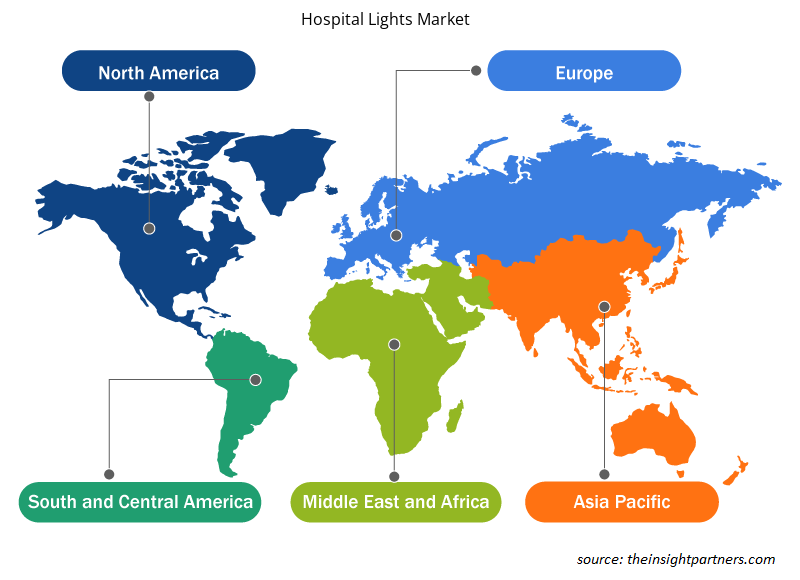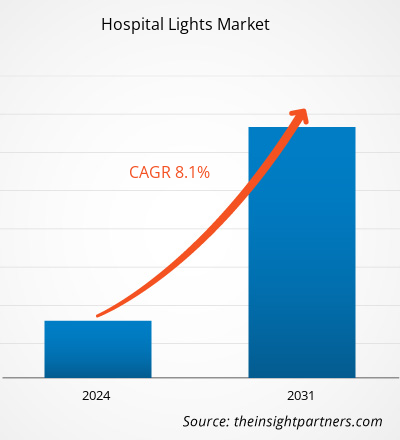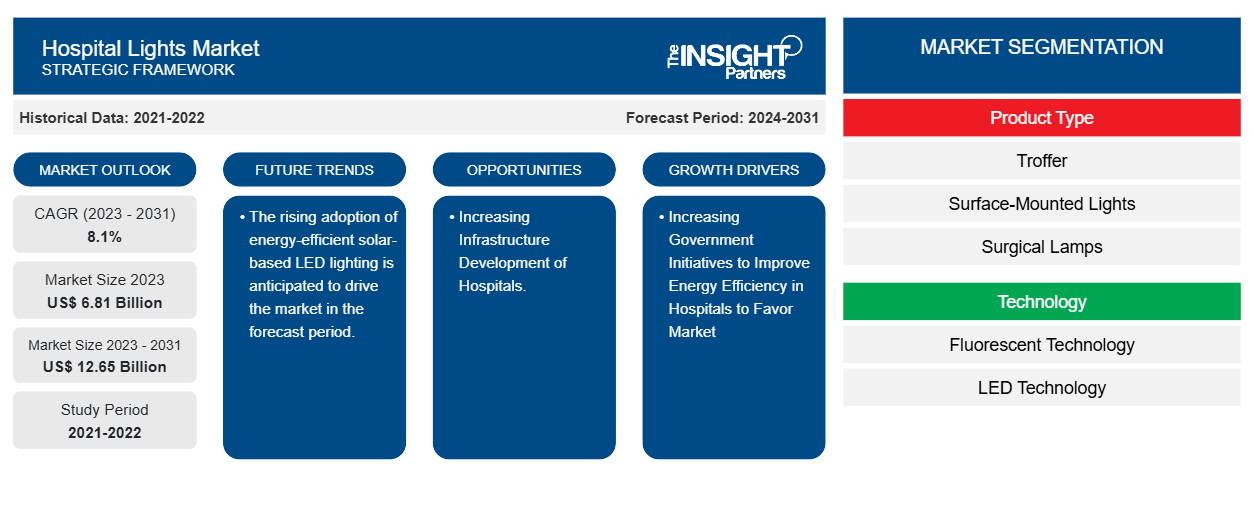Der Markt für Krankenhausbeleuchtung soll von 6,81 Milliarden US-Dollar im Jahr 2023 auf 12,65 Milliarden US-Dollar im Jahr 2031 anwachsen. Der Markt soll zwischen 2023 und 2031 eine durchschnittliche jährliche Wachstumsrate von 8,1 % verzeichnen. Zunehmende staatliche Initiativen zur Verbesserung der Energieeffizienz in Krankenhäusern und die hohe Nachfrage nach LED-Leuchten bei Operationen dürften die wichtigsten Trends und Treiber des Marktes für Krankenhausbeleuchtung sein.
Marktanalyse für Krankenhausleuchten
Der Markt für Krankenhausbeleuchtungen verzeichnet weltweit ein deutliches Wachstum. Dieses Wachstum ist auf Faktoren wie zunehmende staatliche Initiativen zur Verbesserung der Energieeffizienz in Krankenhäusern und die hohe Nachfrage nach LED-Leuchten bei Operationen zurückzuführen. Darüber hinaus wird erwartet, dass der zunehmende Ausbau der Infrastruktur von Krankenhäusern und die zunehmende Einführung effizienter, energieeffizienter, solarbasierter LED-Beleuchtung mehrere Chancen für den Markt für Krankenhausbeleuchtungen bieten.
Marktübersicht für Krankenhausleuchten
Unter Krankenhausbeleuchtung versteht man die künstliche Beleuchtung von Gesundheitseinrichtungen wie Kliniken, Krankenhäusern, Pflegeheimen usw. Krankenhausbeleuchtung kann in zwei Hauptkategorien unterteilt werden: Innenbeleuchtung und Außenbeleuchtung.
Passen Sie diesen Bericht Ihren Anforderungen an
Sie erhalten kostenlos individuelle Anpassungen an jedem Bericht, einschließlich Teilen dieses Berichts oder einer Analyse auf Länderebene, eines Excel-Datenpakets sowie tolle Angebote und Rabatte für Start-ups und Universitäten.
-
Holen Sie sich die wichtigsten Markttrends aus diesem Bericht.Dieses KOSTENLOSE Beispiel umfasst eine Datenanalyse von Markttrends bis hin zu Schätzungen und Prognosen.
Treiber und Chancen auf dem Krankenhausbeleuchtungsmarkt
Zunehmende staatliche Initiativen zur Verbesserung der Energieeffizienz in Krankenhäusern fördern den Markt.
Zunehmende staatliche Initiativen zur Verbesserung der Energieeffizienz in Krankenhäusern treiben tatsächlich das Marktwachstum weltweit voran. Die Beleuchtung spielt in medizinischen Einrichtungen eine entscheidende Rolle. Es geht nicht nur darum, Licht für die Sichtbarkeit bereitzustellen, die Krankenhausbeleuchtung wirkt sich auch auf das Wohlbefinden der Patienten, die Effizienz des medizinischen Personals und das allgemeine Ambiente des Krankenhauses aus. Für dieses Wohlbefinden haben die Regierungen verschiedener Länder und Initiativen gesorgt. So wollte die indische Regierung im Februar 2022 grüne und digitale Krankenhäuser einführen, um Energie zu sparen und den Gesundheitssektor umzugestalten. Im Rahmen dieser Initiative ersetzte die Regierung 33.000 herkömmliche Leuchten durch LED-Leuchten, um bessere Luxwerte und Energieeinsparungen zu erzielen. Unter Berücksichtigung der oben genannten Faktoren treiben mehrere staatliche Initiativen zur Verbesserung der Energieeffizienz in Krankenhäusern den Markt für Krankenhausbeleuchtung an.
Zunehmender Ausbau der Infrastruktur von Krankenhäusern.
Der zunehmende Ausbau der Infrastruktur dürfte dem Markt für Krankenhausbeleuchtungen zahlreiche Chancen bieten. Mit der Verbesserung der Krankenhausinfrastruktur steigt auch die Nachfrage nach Krankenhausbedarf und Energieeffizienz. Darüber hinaus investieren viele Länder in den Ausbau der Krankenhausinfrastruktur. Im März 2024 beispielsweise wurden mit Bundesmitteln massive Verbesserungen der US-Gesundheitsinfrastruktur gefördert. Umfangreiche Projekte für medizinische Einrichtungen erfordern verschiedene Branchenkenntnisse sowie eine Fülle von Geräten, Sicherheitskomponenten und Technologien. Daher wird erwartet, dass die Regierung durch verschiedene Initiativen den Markt für Krankenhausbeleuchtungen vorantreiben wird.
Segmentierungsanalyse des Marktberichts für Krankenhausleuchten
Wichtige Segmente, die zur Ableitung der Marktanalyse für Krankenhausleuchten beigetragen haben, sind Produkttyp, Technologie und Anwendung.
- Basierend auf dem Produkttyp ist der Markt für Krankenhausleuchten in Troffer, Oberflächenleuchten, Operationsleuchten und andere unterteilt. Das Troffer-Segment wird im Prognosezeitraum voraussichtlich einen erheblichen Marktanteil halten.
- Basierend auf der Technologie ist der Markt für Krankenhausbeleuchtung in Leuchtstofftechnologie, LED-Technologie und andere unterteilt. Es wird erwartet, dass das Segment der Leuchtstofftechnologie im Prognosezeitraum einen erheblichen Marktanteil halten wird.
- Nach Anwendung ist der Markt in Patientenstationen und Intensivstationen, Operationssäle, Untersuchungsräume und andere unterteilt. Das Segment Patientenstationen dürfte im Prognosezeitraum einen erheblichen Marktanteil halten.
Marktanteilsanalyse für Krankenhausleuchten nach Geografie
Der geografische Umfang des Marktberichts für Krankenhausleuchten ist hauptsächlich in fünf Regionen unterteilt: Nordamerika, Asien-Pazifik, Europa, Naher Osten und Afrika sowie Süd- und Mittelamerika.
Nordamerika dominiert den Markt für Krankenhausleuchten. Der Markt für Krankenhausleuchten wächst aufgrund der zunehmenden Regierungsinitiativen zur Verbesserung der Energieeffizienz in Krankenhäusern und der hohen Nachfrage nach LED-Leuchten während Operationen in der Region. Darüber hinaus zwingt eine starke Betonung von Forschung und Entwicklung in den entwickelten Volkswirtschaften der USA und Kanadas die nordamerikanischen Akteure dazu, technologisch fortschrittliche Lösungen auf den Markt zu bringen. Darüber hinaus gibt es in den USA eine große Anzahl von Akteuren auf dem Markt für Krankenhausleuchten, die sich zunehmend auf die Entwicklung innovativer Lösungen konzentrieren. All diese Faktoren tragen zum Wachstum des Marktes für Krankenhausleuchten in der Region bei.
Regionale Einblicke in den Markt für Krankenhausleuchten
Die regionalen Trends und Faktoren, die den Markt für Krankenhausleuchten im Prognosezeitraum beeinflussen, wurden von den Analysten von Insight Partners ausführlich erläutert. In diesem Abschnitt werden auch die Marktsegmente und die Geografie von Krankenhausleuchten in Nordamerika, Europa, im asiatisch-pazifischen Raum, im Nahen Osten und Afrika sowie in Süd- und Mittelamerika erörtert.

- Erhalten Sie regionale Daten zum Markt für Krankenhausbeleuchtung
Umfang des Marktberichts zu Krankenhausleuchten
| Berichtsattribut | Details |
|---|---|
| Marktgröße im Jahr 2023 | 6,81 Milliarden US-Dollar |
| Marktgröße bis 2031 | 12,65 Milliarden US-Dollar |
| Globale CAGR (2023 - 2031) | 8,1 % |
| Historische Daten | 2021-2022 |
| Prognosezeitraum | 2024–2031 |
| Abgedeckte Segmente |
Nach Produkttyp
|
| Abgedeckte Regionen und Länder |
Nordamerika
|
| Marktführer und wichtige Unternehmensprofile |
|
Marktteilnehmerdichte: Der Einfluss auf die Geschäftsdynamik
Der Markt für Krankenhausleuchten wächst rasant, angetrieben durch die steigende Nachfrage der Endnutzer aufgrund von Faktoren wie sich entwickelnden Verbraucherpräferenzen, technologischen Fortschritten und einem größeren Bewusstsein für die Vorteile des Produkts. Mit steigender Nachfrage erweitern Unternehmen ihr Angebot, entwickeln Innovationen, um die Bedürfnisse der Verbraucher zu erfüllen, und nutzen neue Trends, was das Marktwachstum weiter ankurbelt.
Die Marktteilnehmerdichte bezieht sich auf die Verteilung der Firmen oder Unternehmen, die in einem bestimmten Markt oder einer bestimmten Branche tätig sind. Sie gibt an, wie viele Wettbewerber (Marktteilnehmer) in einem bestimmten Marktraum im Verhältnis zu seiner Größe oder seinem gesamten Marktwert präsent sind.
Die wichtigsten auf dem Markt für Krankenhausbeleuchtung tätigen Unternehmen sind:
- Signify Holding (Philips)
- Acuity Brands, Inc.
- Cree-Beleuchtung
- Drägerwerk AG & Co. KGaA
- KLS Martin Group
- Stryker Corporation
Haftungsausschluss : Die oben aufgeführten Unternehmen sind nicht in einer bestimmten Reihenfolge aufgeführt.

- Überblick über die wichtigsten Akteure auf dem Markt für Krankenhausleuchten
Neuigkeiten und aktuelle Entwicklungen zum Krankenhausleuchtenmarkt
Der Markt für Krankenhausbeleuchtung wird durch die Erhebung qualitativer und quantitativer Daten nach Primär- und Sekundärforschung bewertet, die wichtige Unternehmensveröffentlichungen, Verbandsdaten und Datenbanken umfasst. Nachfolgend sind einige der Entwicklungen auf dem Markt für Krankenhausbeleuchtung aufgeführt:
- Royal Philips, ein weltweit führendes Unternehmen im Bereich Gesundheitstechnologie, gab eine strategische Partnerschaft zur Integration der fortschrittlichen Lösung viQtor von smartQare mit den weltweit führenden klinischen Patientenüberwachungsplattformen von Philips bekannt. Diese Zusammenarbeit zielt darauf ab, die nächste Generation der kontinuierlichen Patientenüberwachung sowohl innerhalb als auch außerhalb des Krankenhauses zu ermöglichen, beginnend in Europa. (Quelle: Royal Philips Company Website, April 2024)
Marktbericht zu Krankenhausleuchten – Abdeckung und Ergebnisse
Der Bericht „Marktgröße und Prognose für Krankenhausbeleuchtung (2021–2031)“ bietet eine detaillierte Analyse des Marktes, die die folgenden Bereiche abdeckt:
- Marktgröße und Prognose für Krankenhausleuchten auf globaler, regionaler und Länderebene für alle wichtigen Marktsegmente, die im Rahmen des Berichts abgedeckt sind
- Markttrends für Krankenhausleuchten sowie Marktdynamik wie Treiber, Einschränkungen und wichtige Chancen
- Detaillierte PEST/Porters Five Forces- und SWOT-Analyse
- Marktanalyse für Krankenhausleuchten mit Blick auf wichtige Markttrends, globale und regionale Rahmenbedingungen, wichtige Akteure, Vorschriften und aktuelle Marktentwicklungen
- Branchenlandschaft und Wettbewerbsanalyse, einschließlich Marktkonzentration, Heatmap-Analyse, prominenten Akteuren und aktuellen Entwicklungen auf dem Markt für Krankenhausbeleuchtung
- Detaillierte Firmenprofile
- Historische Analyse (2 Jahre), Basisjahr, Prognose (7 Jahre) mit CAGR
- PEST- und SWOT-Analyse
- Marktgröße Wert/Volumen – Global, Regional, Land
- Branchen- und Wettbewerbslandschaft
- Excel-Datensatz
Aktuelle Berichte
Verwandte Berichte
Erfahrungsberichte
Grund zum Kauf
- Fundierte Entscheidungsfindung
- Marktdynamik verstehen
- Wettbewerbsanalyse
- Kundeneinblicke
- Marktprognosen
- Risikominimierung
- Strategische Planung
- Investitionsbegründung
- Identifizierung neuer Märkte
- Verbesserung von Marketingstrategien
- Steigerung der Betriebseffizienz
- Anpassung an regulatorische Trends























 Kostenlose Probe anfordern für - Markt für Krankenhausbeleuchtung
Kostenlose Probe anfordern für - Markt für Krankenhausbeleuchtung